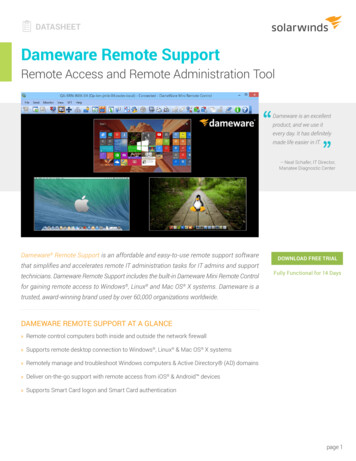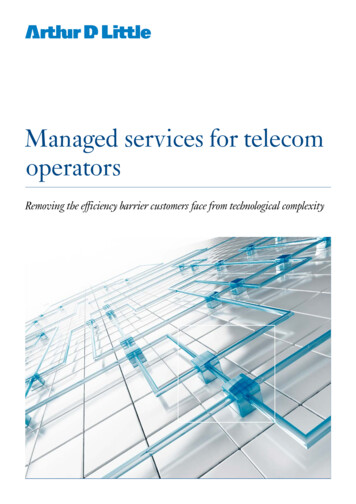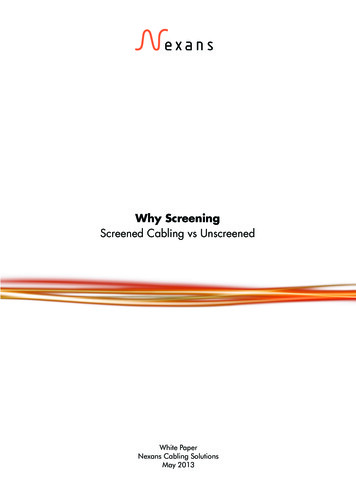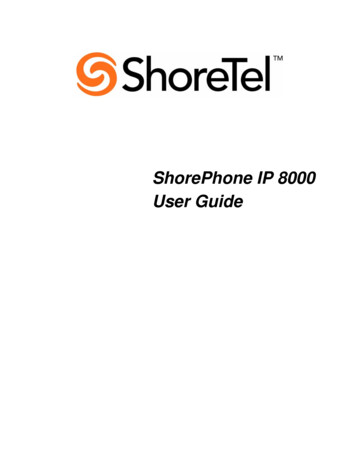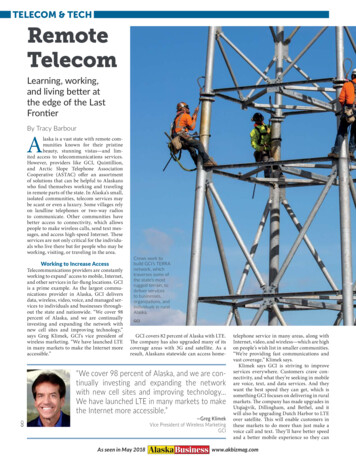
Transcription
TELECOM & TECHRemoteTelecomLearning, working,and living better atthe edge of the LastFrontierBy Tracy BarbourAlaska is a vast state with remote communities known for their pristinebeauty, stunning vistas—and limited access to telecommunications services.However, providers like GCI, Quintillion,and Arctic Slope Telephone AssociationCooperative (ASTAC) offer an assortmentof solutions that can be helpful to Alaskanswho find themselves working and travelingin remote parts of the state. In Alaska’s small,isolated communities, telecom services maybe scant or even a luxury. Some villages relyon landline telephones or two-way radiosto communicate. Other communities havebetter access to connectivity, which allowspeople to make wireless calls, send text messages, and access high-speed Internet. Theseservices are not only critical for the individuals who live there but for people who may beworking, visiting, or traveling in the area.Working to Increase AccessTelecommunications providers are constantlyworking to expand’ access to mobile, Internet,and other services in far-flung locations. GCIis a prime example. As the largest communications provider in Alaska, GCI deliversdata, wireless, video, voice, and managed services to individuals and businesses throughout the state and nationwide. “We cover 98percent of Alaska, and we are continuallyinvesting and expanding the network withnew cell sites and improving technology,”says Greg Klimek, GCI’s vice president ofwireless marketing. “We have launched LTEin many markets to make the Internet moreaccessible.”Crews work tobuild GCI’s TERRAnetwork, whichtraverses some ofthe state’s mostrugged terrain, todeliver servicesto businesses,organizations, andindividuals in ruralAlaska.GCIGCI covers 82 percent of Alaska with LTE.The company has also upgraded many of itscoverage areas with 3G and satellite. As aresult, Alaskans statewide can access home-“We cover 98 percent of Alaska, and we are continually investing and expanding the networkwith new cell sites and improving technology.We have launched LTE in many markets to makethe Internet more accessible.”GCI—Greg KlimekVice President of Wireless MarketingGCIAs seen in May 2018telephone service in many areas, along withInternet, video, and wireless—which are highon people’s wish list in smaller communities.“We’re providing fast communications andvast coverage,” Klimek says.Klimek says GCI is striving to improveservices everywhere. Customers crave connectivity, and what they’re seeking in mobileare voice, text, and data services. And theywant the best speed they can get, which issomething GCI focuses on delivering in ruralmarkets. The company has made upgrades inUtqiaġvik, Dillingham, and Bethel, and itwill also be upgrading Dutch Harbor to LTEover satellite. This will enable customers inthese markets to do more than just make avoice call and text. They’ll have better speedand a better mobile experience so they canwww.akbizmag.com
As seen in May 2018www.akbizmag.com
GCI“[Anchor tenants such as school districts andhealthcare facilities] are the largest employersin rural Alaska, and they’re why and how webring broadband into the community.But we don’t stop there. We bring Internetinto the home and cell service into thecommunity.”—Pam LloydVice President of Government,Healthcare, and Education, GCIuse an iPhone or Android cell phone, amongother things.GCI provides service to more than 240communities across Alaska and has approximately forty retail stores statewide, according to Jenifer Nelson, senior manager of community relations. So if rural travelers findthemselves facing a communication problemin Nome, for instance, they can visit a retailstore for help. Alaska Commercial Companyresellers and wholesalers also offer GCI products throughout rural Alaska. “We also haveFast Phone, which is a prepaid wireless option that’s popular with seasonal workers andtravelers,” Nelson says.As part of its ongoing investment in ruralAlaska, GCI recently made enhancementsat Shungnak, an Iñupiat village with about270 residents. The company “turned on” LTEover satellite in the northwest Alaska community in December. “They are outside ourterrestrial footprint, so this new technologyallows them to use the latest smartphonetechnology and have better access to services,” Nelson says.Having LTE over satellite allows people insmall communities to download streamingservices, use YouTube, and do many otherthings that customers can do in places likeAnchorage or Seattle. LTE over satellite alsohas even broader implications, particularlyin the areas of education and healthcare. Theability to have mobility is extremely important, and many students are using broadbandfor their homes, according to Pam Lloyd,PhD, GCI’s vice president of government,healthcare, and education. Broadband alsofacilitates telemedicine, which is a vital service in rural areas with restricted access tomedical specialists.In addition to network upgrades, GCI hasenhanced its Internet service by offering a NoWorries Plan for rural Alaska hub communities. The company introduced No WorriesInternet plans in Bethel, Nome, and Kotzebue in July. Essentially, the plans double dataand decrease the monthly price for the majority of GCI’s customers in these communities. They also eliminate burdensome overagecharges. With the No Worries plans, customers who reach their monthly data limit havethe option to continue their use at a reducedspeed for the rest of the month or purchaseadditional data.GCI was able to increase data usage for itsrural customers because of recent upgradesto its TERRA (Terrestrial for Every RuralRegion in Alaska) network. The networkprovides high-speed broadband service tomore than seventy communities in ruralAlaska. Over the past eight years GCI hasinvested more than 250 million in TERRA.As new technology becomes available, it willcontinue to upgrade the network to provideeven greater speeds and data packages forcustomers.TERRA is a hybrid terrestrial fiber-opticand microwave network that removes thelimitations of satellite and provides symmetrical broadband service to Alaska’s remote andrural regions. With a direct land-based connection to Anchorage and the Internet, theTERRA network delivers critical bandwidthto numerous public, nonprofit, and privateentities such as regional health corporations,school districts, native organizations, andresidents.In fact, much of the reason why GCI hasbeen able to build out many of the rural areas is because of “anchor tenants” like schooldistricts and healthcare facilities, Lloyd says.“They are the largest employers in rural Alaska, and they’re why and how we bring broadband into the community,” she explains. “Butwe don’t stop there. We bring Internet into thehome and cell service into the community.”Klimek says GCI has worked hard to buildout its expansive TERRA network, the perimeter of which is almost 3,300 miles—slightlylarger than the Texas border. The terrain inrural Alaska can be rugged and unforgiving,which make the logistics of the build-out challenging at times. For instance, in southwestAlaska near Naknek, a diver had to plungethrough frigid ice to lay fiber under a river bed.GCI’s completion of the TERRA networkallows individuals who depend on its services for work and other uses to have greaterreliability. “It was a tremendous feat, but itdoes provide great service to our customer,”Klimek says. “If we have a problem along theTERRA network, we have redundancy so itdoesn’t go down.”Quintillion is also facilitating broadbandand mobile solutions with its fiber optic cablesystem. The system, which delivers gigabit andhigher bandwidth services on a 1,400 milesubsea and terrestrial fiber optic network,went live in December 2017. It includes a subsea trunk line from Prudhoe Bay to NomeAs seen in May 2018with branching lines to five communities:Wainwright, Point Hope, Nome, Kotzebue,and Utqiaġvik—the northernmost city in theUnited States.Quintillion is a wholesale bandwidth services provider, and now these communitiescan take advantage of its subsea fiber opticcable system to capitalize on twenty-firstcentury communications in the Alaska Arctic. Consequently, telecom providers can useQuintillion’s system to gain access to highspeed broadband capacity at a far lower costand improved quality of service than existingsatellite and microwave options, according toa February press release.www.akbizmag.com
The perimeter of GCI’sTERRA network isnearly 3,300 miles—slightly larger than theTexas border.GCIThe advent of faster Internet to Quintillion’smarkets will enhance health and educationservices, help stimulate economic development, empowers local businesses, and allowconsumers to use video and other high-speedapplications that many potential Quintillionend-user customers previously did not have access to or could not afford. Ultimately, serviceoptions in these remote communities will depend on what different retail providers chooseto offer their customers.ASTAC also focuses on delivering telecommunications services to distant areas ofthe state. The full-service, member-ownedutility has been providing telecom servicesto North Slope residents since 1981. ASTACprovides local and long distance, 4G wireless,broadband Ethernet and Internet, and dataservices to Utqiaġvik, Wainwright, Atqasuk,Anaktuvuk Pass, Nuiqsut, Kaktovik, PointHope, and Point Lay. It also delivers telecommunications solutions to the productioncomplex at Deadhorse-Prudhoe Bay.“ASTAC’s designated service area is a roadless, remote Arctic area between Point Hopeand Kaktovik—more than 90,000 squaremiles, which is larger than forty of the fiftystates,” says Thomas Lochner, ASTAC’s director of business development. “Our 4G wirelessservice reaches as far as seven miles out to sea.”As seen in May 2018Now Alaskans who are traveling inASTAC’s coverage area will have greater access to wireless and Internet services. Earlierthis year, ASTAC completed the installationof fiber optic cabling in the villages of Nuiqsut, Wainwright, and Point Hope. And in2006, ASTAC technicians installed fiber toall of the buildings in these communities. Thenew distribution fiber provides an end-to-endfiber optic broadband connection when combined with Quintillion’s subsea fiber network.Currently, people in Nuiqsut, Wainwright,and Point Hope have the highest bandwidthand lowest latency services that they have everexperienced.www.akbizmag.com
Coverage for the Dalton HighwayTelecom coverage is also being enhancedalong the James W. Dalton Highway, oftenreferred to as the Dalton Highway or HaulRoad. The Dalton Highway used to be considered one of the most isolated stretches ofroad in the United States. The 414-mile roadruns from the Elliott Highway north of Fairbanks to the “community” of Deadhorse,which serves the Prudhoe Bay Oil Fields.In July, GCI completed a new wirelesstower near Coldfoot and brought the firstever wireless service to the Dalton Highway.Previously, there had been no cell phone service along the road, and travelers had to communicate by Citizens Band radio or satellitephone. As many as 250 trucks use the Dalton“ASTAC’s designated service area is a roadless,remote Arctic area between Point Hope andKaktovik—more than 90,000 square miles,which is larger than forty of the fifty states Our 4G wireless service reaches as far as sevenmiles out to sea.”—Thomas LochnerDirector of Business DevelopmentASTACHighway each day, and GCI’s wireless coverage is a much-needed solution for these andother travelers who depend on cell phones.The new tower provides wireless coveragealong 15 miles of the Dalton Highway. “Therewas a big gap before,” Klimek says. “This provides a good amount of coverage.”The tower—located near mile 175—costabout 500,000 and took a year to permit,construct, and integrate into the GCI wireless network. GCI is planning other wirelesstowers along the road as part of a 30 millionproject to expand and upgrade wireless communication throughout the state.ASTAC is also working to address thedearth of telecommunications coveragealong the Dalton Highway. The utility, alongAs seen in May 2018with a number of partners, is planning tobuild more cell towers along the highway.The first tower will be placed at the Franklin Bluffs area and will meet the coverageASTAC already provides for Deadhorse andslightly southward. While ASTAC’s new towers will not cover the entire highway, theywill provide a considerable amount of coverage that people did not have before.The utility is also working on a solution toaddress places where Alaskans are completely off the telecom grid and have to rely on satellite phones. It offers Beartooth, an off-thegrid network for smartphones. Beartoothallows individuals who are not connectedto a wireless or satellite network to use cellphones to keep in contact off grid up to awww.akbizmag.comASTACASTACASTAC says it is excited to offer high quality Internet service at faster speeds and withlower latency. Now all of its wireline and 4Gwireless customers in Wainwright, PointHope, Nuiqsut, and Utqiaġvik can enjoy thebenefits of the fiber-fed networks. ASTACis now migrating customers in all fiber-fedmarkets to its faster Home Internet10 service.Lochner says Quintillion’s fiber only lands athalf of the villages ASTAC serves. “ASTAChas a goal within the next five years to link allof the villages together on terrestrial bandwidth,” he says.Since 2012, ASTAC has invested morethan 33 million in its North Slope network.
The terrain in rural Alaskacan be rugged andunforgiving, which make thelogistics of the TERRAbuild-out challenging at times.For instance, in southwestAlaska near Naknek,a diver had to plungethrough frigid ice to lay fiberunder a river bed.ten-mile range. They can text up to ten milesand push to talk up to five miles away usingBeartooth and a custom phone app.Impact of Services in Remote AreasUpgraded telecom solutions are making itmore feasible to work, live, and play in someof the remote regions of Alaska. ASTAC provides the largest cell coverage footprint onthe North Slope, from Point Thomson onthe east to west of Alpine, south to FranklinBluffs, and up to seven miles out in the Beaufort Sea going north. ASTAC’s cell service ishelping whalers stay in contact while at seawithin the seven-mile coverage area, whichenhances their ability to work more safely.ASTAC’s Beartooth allows search and res-cue parties to use their cell phones to connecteven when they’re off the telecommunications grid, enhancing their ability to performlife-saving work. Beartooth is also providingan extra level of safety and communicationsfor hunting parties.Oil and gas exploration both west andsouth of Nuiqsut (on the Colville River) isenhanced due to cellular coverage throughan ASTAC partnership.GCI is also seeing the positive impact oftelecommunications in rural Alaska. Forexample, a search and rescue team was ableto rescue a snow machiner who was lost ina blizzard because he was able to send themhis location from his iPhone and a businesscustomer was able to use his smartphone toapprove time cards for his employees whilehe was fishing on the river in Bethel.Enhanced telecom services are also havinga positive effect on shopping in the Bush. Infact, shortly after some of the communitiesoutside Bethel received enhanced services,one freight carrier became overloaded withAmazon boxes: with faster data speeds, residents were able to shop online instead of having to purchase all their items locally.GCI is also providing a telecom solutionfor teachers who move to Alaska’s remoteareas from the Lower 48. Many of themfind that their service from national carriers doesn’t work in some parts of the state sothey switch to GCI to remedy the situation.Telecommunications technology is alsohelping to save lives. GCI’s support of tele-As seen in May 2018medicine and telehealth is making it possiblefor Alaskans in remote communities to getin contact with specialists instead of havingto travel thousands of miles into Anchorage.This is especially crucial given the fact thatfaster access to healthcare can save lives. “Inthe healthcare world, time is life,” Nelsonsays.Telecom services are also having a professional impact on the lives young people.Thanks to high-speed Internet service,Byron Nicholai of Toksook Bay has been ableto share his singing, dancing, and other talents with the world. His “I Sing, You Dance”videos have made him a YouTube sensationand led him to perform at the White Housefor President Barrack Obama and other venues worldwide.Social media was instrumental in the success of Nick Hanson from the 750-person village of Unalakleet. Hanson was featured onAmerica Ninja Warrior and now has a broadplatform to promote the benefits of exerciseto youth everywhere. “These are the storiesthat make a difference to people who live inrural Alaska,” says Lloyd. “We provide service to the world, no matter the zip code.” RTracy Barbour has been an AlaskaBusiness contributor since 1999. As aformer Alaskan, she is uniquely positionedto offer in-depth insight and enjoyswriting about a variety of topics.www.akbizmag.com
working to expand’ access to mobile, Internet, and other services in far-lung locations. GCI is a prime example. As the largest commu-nications provider in Alaska, GCI delivers data, wireless, video, voice, and managed ser - vices to individuals and busi



